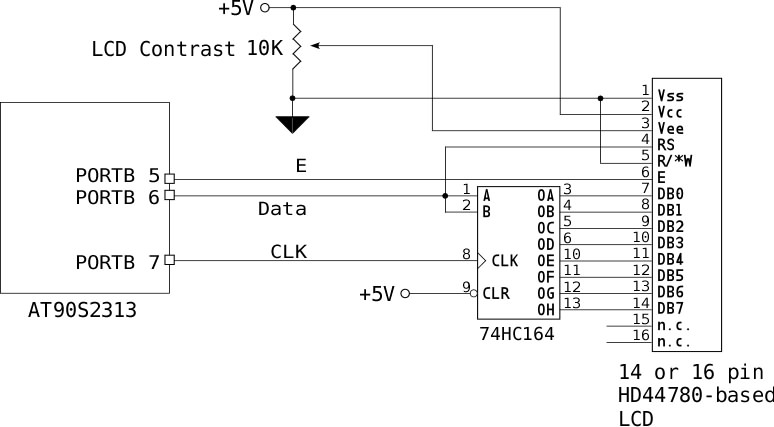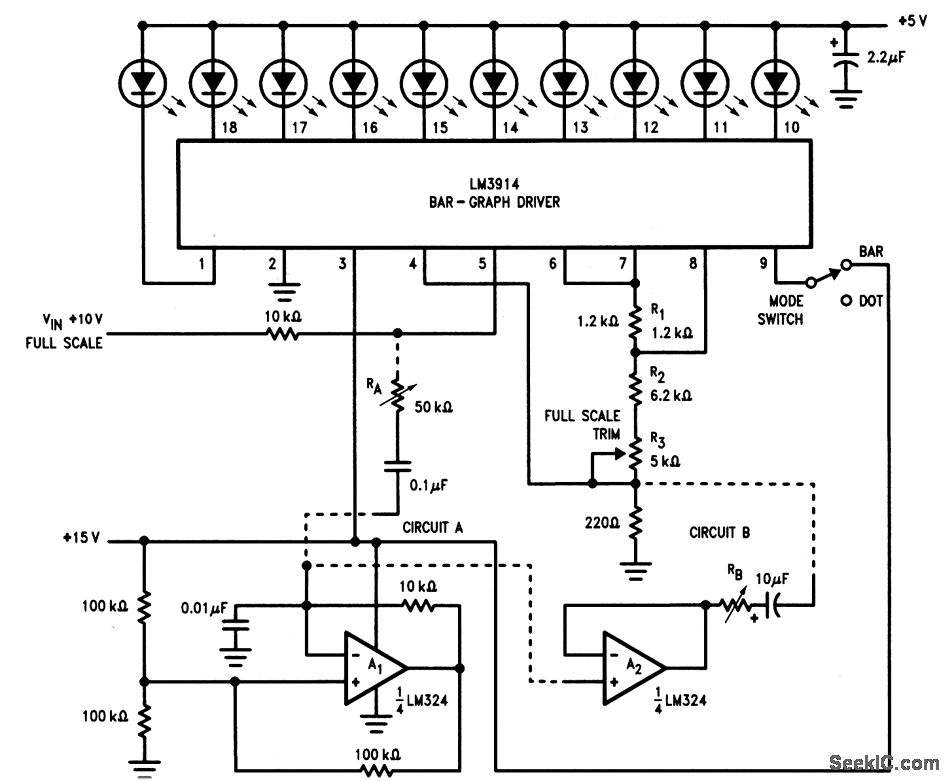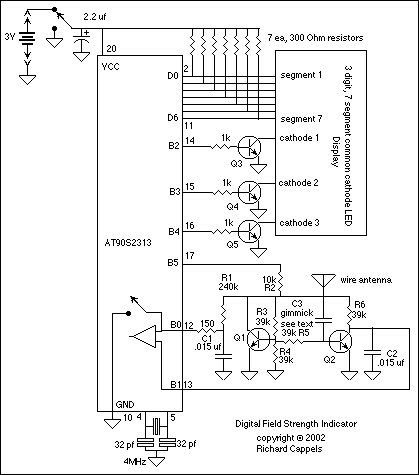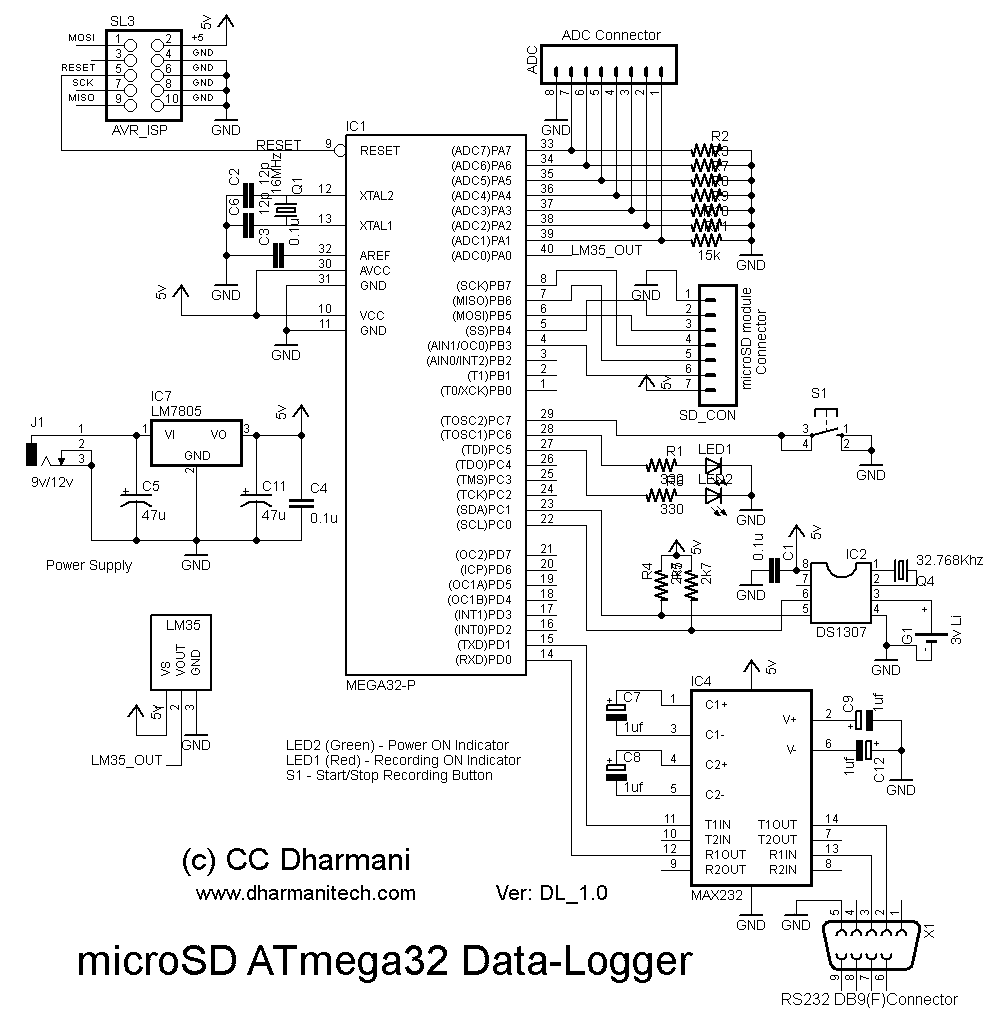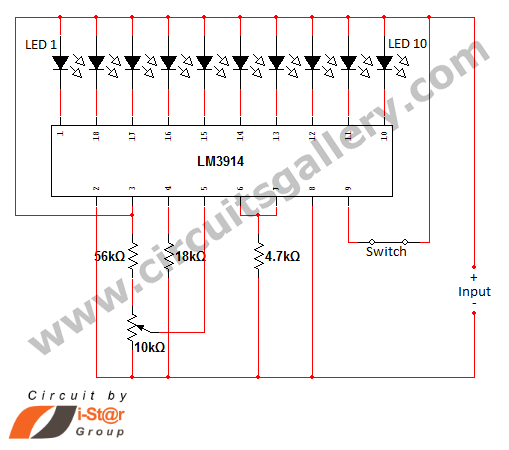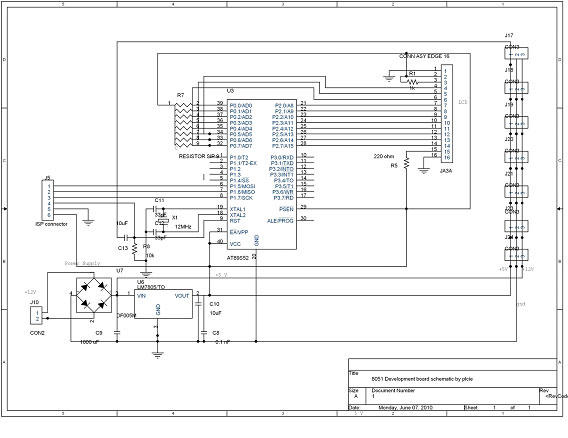
Atmel AVR and 8051 series ISP programmer

This ISP Programmer can be utilized for in-system programming or as a standalone SPI programmer for Atmel ISP programmable devices. The programming interface is compatible with STK200 ISP programmer hardware, allowing users of STK200 to also employ the software that can program both the 8051 and AVR series devices. The circuit diagram of the in-system programmer interface illustrates that the power to the interface is supplied by the target system. The 74HCT541 IC isolates and buffers the parallel port signals, and it is crucial to use the HCT type IC to ensure compatibility with 3V type parallel ports. The circuit diagram of the standalone SPI programmer indicates that power is supplied by the PC USB port, which can provide a maximum of 100mA current. A low-cost USB cable can be modified by cutting the connector at one end and attaching a crimp shell connector, where the red wire corresponds to 5V and the black wire to 0V. This programmer circuit can be used to program the 89S series devices and AVR series devices that are pin-compatible with the 8051, such as the 90S8515. For other AVR series devices, an adapter board can be created for 20, 28, and 40 pin devices. The pin numbers in brackets correspond to the PC parallel port connector. The ISP-3v0.zip file contains the main program and the I/O port driver for Windows 2000 and XP. All files should be placed in the same folder; for Windows 95/98, the "ISP-Pgm3v0.exe" file should be used, while for Windows 2000 and XP, the "ISP-XP.bat" file is required. The main screen view of the program is depicted in the circuit diagram. It is important not to program the RSTDISBL fuse in the ATmega8, ATtiny26, and ATtiny2313, as this would disable further SPI programming, necessitating the use of a parallel programmer to re-enable SPI programming. For fuse settings, it is advised to consult the respective device datasheet. For automatic hardware detection, it is essential to short pin 2 and pin 12 of the DB25 connector; otherwise, the software will default to the parallel port LPT1. The software currently includes only the devices that have been verified for correct programming; updates will be made as new devices are acquired. The memory buffer contains both code data and EEPROM data for devices equipped with EEPROM memory. The EEPROM memory address in the buffer begins after the code memory, therefore the hex file must contain the EEPROM start address following the last address of code memory; for example, for the 90S2313, the EEPROM memory starts at address 0x800. The software does not provide an erase command, as this function is automatically executed during device programming. To erase the controller, the clear buffer command should be used prior to programming the controller, which will erase the controller and reset the AVR device fuses to their default settings.
The ISP Programmer is designed to facilitate both in-system and standalone programming of Atmel ISP programmable devices, leveraging compatibility with existing STK200 hardware. The operational flexibility of this programmer is enhanced by its ability to interface with both 8051 and AVR series devices, making it a versatile tool for developers and engineers.
The circuit diagram of the in-system programmer highlights the necessity of using the 74HCT541 integrated circuit, which serves to isolate and buffer signals from the parallel port. This is particularly important for ensuring proper functionality with 3V parallel ports, which are increasingly prevalent in modern computing environments.
The standalone SPI programmer circuit emphasizes the use of a USB connection for power, which is a common and convenient method for powering programming devices. The modification of a standard USB cable to connect to the programmer is straightforward, with clear color coding for power connections. This design choice allows for easy integration into existing setups without the need for specialized power supplies.
Furthermore, the programmer's compatibility with various AVR series devices, including the 89S series and pin-compatible models, expands its usability. The option to create adapter boards for different pin configurations provides additional flexibility for users who may work with a range of devices.
The software component is well-structured, with specific instructions for different Windows operating systems, ensuring that users have a clear pathway to installation and operation. The inclusion of automatic hardware detection simplifies the setup process, although users must take care to configure the DB25 connector correctly to avoid issues.
The memory management aspect of the programming process is also noteworthy. The separation of code and EEPROM data within the memory buffer allows for organized programming, and the requirement for proper hex file formatting ensures that programming is executed smoothly without errors. The automatic erase function during programming is a valuable feature that streamlines the workflow, although users must be aware of the need to reset fuses to default settings when necessary.
In conclusion, the ISP Programmer presents a robust solution for programming Atmel ISP devices, combining ease of use with flexible configuration options. Its thoughtful design and comprehensive software support make it an essential tool for electronics engineers and developers engaged in embedded systems programming.This ISP Programmer can be used either for in-system programming or as a stand-alone spi programmer for Atmel ISP programmable devices. The programming interface is compatible to STK200 ISP programmer hardware so the users of STK200 can also use the software which can program both the 8051 and AVR series devices.
Figure 1 shows the circuit diagram of the in-system programmer interface, the power to the interface is provided by the target system. The 74HCT541 ic isolate and buffer the parallel port signals. It is necessary to use the HCT type ic in order to make sure the programmer should work with 3v type parallel port. Figure 2 shows the circuit diagram of the stand-alone spi programmer, the power to the interface is provided by the PC USB port which can supply a max of 100mA current.
Get a cheap USB cable, cut the cable other end connector and attach a crimp shell connector to this end, red wire is 5v and black is 0v. This programmer circuit can be use to program the 89S series devices and the AVR series devices which are pin compatible to 8051, like 90S8515.
For other AVR series devices the user can make an adapter board for 20, 28 and 40 pin devices. The pin numbers shown in brackets correspond to PC parallel port connector. The ISP-3v0. zip file contains the main program and the i/o port driver for windows 2000 & XP. Place all files in the same folder, for win-95/98 use the "ISP-Pgm3v0. exe" file, for win-2000 & XP use the "ISP-XP. bat" file. The main screen view of the program is shown in figure 3. Also make sure do not program the RSTDISBL fuse in ATmega8, ATtiny26 and ATtiny2313 otherwise further spi programming is disable and you will need a parallel programmer to enable the spi programming. For the fuses setting consult the datasheet of the respective device. For the auto hardware detection it is necessary to short pin 2 and 12 of DB25 connector, otherwise the software uses the default parallel port i.
e. LPT1. I have only included the devices which I have in hand, and verified their correct programming, when I will get the other devices the software will be updated. The memory buffer contains both the code data and the eeprom data for the devices which have eeprom memory.
The eeprom memory address in buffer is started after the code memory, so it is necessary the hex file should contains the eeprom start address after the end of code memory last address i. e. for 90S2313 the start address for eeprom memory is 0x800. The software does not provide the erase command because this function is performed automatically during device programming.
If you are required to erase the controller, first use the clear buffer command then program the controller, this will erase the controller and also set the AVR device fuses to default setting. 🔗 External reference
The ISP Programmer is designed to facilitate both in-system and standalone programming of Atmel ISP programmable devices, leveraging compatibility with existing STK200 hardware. The operational flexibility of this programmer is enhanced by its ability to interface with both 8051 and AVR series devices, making it a versatile tool for developers and engineers.
The circuit diagram of the in-system programmer highlights the necessity of using the 74HCT541 integrated circuit, which serves to isolate and buffer signals from the parallel port. This is particularly important for ensuring proper functionality with 3V parallel ports, which are increasingly prevalent in modern computing environments.
The standalone SPI programmer circuit emphasizes the use of a USB connection for power, which is a common and convenient method for powering programming devices. The modification of a standard USB cable to connect to the programmer is straightforward, with clear color coding for power connections. This design choice allows for easy integration into existing setups without the need for specialized power supplies.
Furthermore, the programmer's compatibility with various AVR series devices, including the 89S series and pin-compatible models, expands its usability. The option to create adapter boards for different pin configurations provides additional flexibility for users who may work with a range of devices.
The software component is well-structured, with specific instructions for different Windows operating systems, ensuring that users have a clear pathway to installation and operation. The inclusion of automatic hardware detection simplifies the setup process, although users must take care to configure the DB25 connector correctly to avoid issues.
The memory management aspect of the programming process is also noteworthy. The separation of code and EEPROM data within the memory buffer allows for organized programming, and the requirement for proper hex file formatting ensures that programming is executed smoothly without errors. The automatic erase function during programming is a valuable feature that streamlines the workflow, although users must be aware of the need to reset fuses to default settings when necessary.
In conclusion, the ISP Programmer presents a robust solution for programming Atmel ISP devices, combining ease of use with flexible configuration options. Its thoughtful design and comprehensive software support make it an essential tool for electronics engineers and developers engaged in embedded systems programming.This ISP Programmer can be used either for in-system programming or as a stand-alone spi programmer for Atmel ISP programmable devices. The programming interface is compatible to STK200 ISP programmer hardware so the users of STK200 can also use the software which can program both the 8051 and AVR series devices.
Figure 1 shows the circuit diagram of the in-system programmer interface, the power to the interface is provided by the target system. The 74HCT541 ic isolate and buffer the parallel port signals. It is necessary to use the HCT type ic in order to make sure the programmer should work with 3v type parallel port. Figure 2 shows the circuit diagram of the stand-alone spi programmer, the power to the interface is provided by the PC USB port which can supply a max of 100mA current.
Get a cheap USB cable, cut the cable other end connector and attach a crimp shell connector to this end, red wire is 5v and black is 0v. This programmer circuit can be use to program the 89S series devices and the AVR series devices which are pin compatible to 8051, like 90S8515.
For other AVR series devices the user can make an adapter board for 20, 28 and 40 pin devices. The pin numbers shown in brackets correspond to PC parallel port connector. The ISP-3v0. zip file contains the main program and the i/o port driver for windows 2000 & XP. Place all files in the same folder, for win-95/98 use the "ISP-Pgm3v0. exe" file, for win-2000 & XP use the "ISP-XP. bat" file. The main screen view of the program is shown in figure 3. Also make sure do not program the RSTDISBL fuse in ATmega8, ATtiny26 and ATtiny2313 otherwise further spi programming is disable and you will need a parallel programmer to enable the spi programming. For the fuses setting consult the datasheet of the respective device. For the auto hardware detection it is necessary to short pin 2 and 12 of DB25 connector, otherwise the software uses the default parallel port i.
e. LPT1. I have only included the devices which I have in hand, and verified their correct programming, when I will get the other devices the software will be updated. The memory buffer contains both the code data and the eeprom data for the devices which have eeprom memory.
The eeprom memory address in buffer is started after the code memory, so it is necessary the hex file should contains the eeprom start address after the end of code memory last address i. e. for 90S2313 the start address for eeprom memory is 0x800. The software does not provide the erase command because this function is performed automatically during device programming.
If you are required to erase the controller, first use the clear buffer command then program the controller, this will erase the controller and also set the AVR device fuses to default setting. 🔗 External reference
